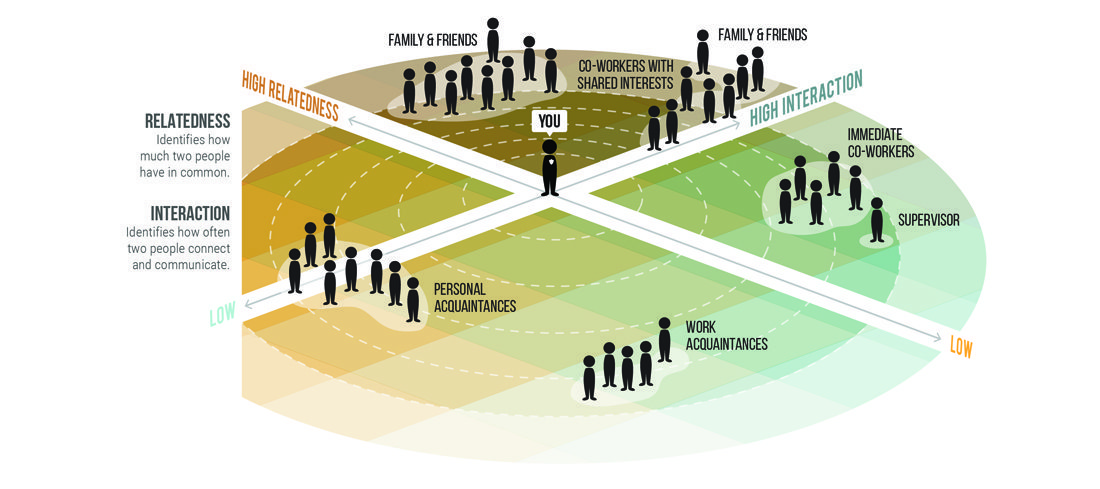The secret to boosting employee engagement lies in learning how to build professional relationships throughout your organization.
If the state of engagement is what we observe when employees are motivated, productive, and satisfied in their roles beyond normal levels, then relationships are what carry them across that threshold. When the relationships in an organization are strong, they imbue work with meaning–a daily sense of purpose that amounts to more than if you’re just working for yourself. Employees will feel motivated to give more at work, not because they feel obligated to, but because they want to do more for their colleagues and the company.
This is not conjecture. Over the years, several organizations have conducted research demonstrating this link. Most notably, Gallup, a global leader in defining and measuring employee engagement, found that friendships in the workplace were so impactful on engagement that it identified strong relationships as one of 12 traits of highly productive work groups. Additionally, the Society for Human Resource Management, or SHRM, reports relationships with coworkers as the top condition for employees engagement.
Related: 6 Tips to Build Professional Relationships Across Generations
Relationships at work are also incredibly important to millennials, a generation it bears reminding that took the lead of the U.S. labor force in 2015 and is on track to become 50% of the global workforce by 2020. Per a study from LinkedIn, more than half say friendships at work make them happy, and 50% say these relationships motivate them. In sum, organizations that learn and promote how to build professional relationships as part of their culture will have a key competitive advantage attracting the most skilled talent from this important demographic.
How to build professional relationships across the spectrum
Every relationship in an organization falls somewhere on the workplace relationship spectrum. As identified by our white paper, How Relationships Shape Engagement and Culture, the workplace relationship spectrum charts all relationships in an organization in response to two factors: interaction and relatedness. Interaction describes how much two employees connect and communicate with each other on a daily basis. Relatedness, on the other hand, is a term that has a big, stuffy life in academic circles, but here it refers to how much two colleagues have in common. Refer to the chart below for examples of where different types of relationships fall on the spectrum.
As you can see, relationships high in relatedness in interaction are often family, friends, and coworkers in similar roles who have shared interests. Those low in both are often work acquaintances, maybe someone from a different department, or even work location, who you only know in passing. Someone you interact with frequently but don’t have much in common with might be a supervisor or manager (to a leader, this would be your direct reports). Finally, relationships with high relatedness but low interaction might be friendly acquaintances limited by the lack of available spaces and tools for communication.
Now, you may be squinting at this chart and racking your brain trying to find the relationships in the sweet spot of interaction and relatedness that will be the most engaging. Let me stop you right there. Every relationship in the workplace matters.
Yes, relationships between colleagues high in relatedness and interaction have a clear and present impact on an employee’s daily work experience. These are people who see each other every day and likely have a strong understanding of how each succeeds in their roles. Of course the way these people treat each other is going to have a significant impact on their daily sense of engagement. But it goes so much further beyond team members. The relationships between department heads, the relationships executives have with their workforces, even casual acquaintances you have with people on the whole other side of the building, they all count too.
The nature of every single one of these relationships contributes to a holistic sense of engagement across an organization. This is because the way you treat an employee–and the way an employee treats another employee and so on and so forth–reflects what you value about their contributions to the company, regardless of their role. Even a custodian whose duties may not immediately to connect to the “big picture” can feel a sense of purpose and employee engagement in their role if they have relationships that make them feel valued.
So if the relationships you encourage are negative, deconstructive, and toxic, employees won’t feel the necessary trust and other emotions that improve workplace engagement. But if the relationships you promote are positive, constructive, and supportive, camaraderie will rise as employees discover ingenious ways to collaborate, innovate, and help each other.
3 resources for relationship building opportunities
So what do you need to know about how to build professional relationships? Camaraderie is earned. You can’t snap your fingers and make everyone best friends overnight (although that would be nice). To create an engagement framework around workplace relationships, you have to support opportunities for interaction and the discovery of commonality. Translation: create spaces where employees feel comfortable connecting and then get them to connect.
Naturally, some of these spaces may already exist. The breakroom and the watercooler chats that occur there are often the first thing that comes to mind when we think about connecting with colleagues. Coworkers, of course, also connect in their office spaces and in the hallways of the organization, and any other place where they might organically gather. But just because some socialization already occurs in these spaces doesn’t mean it can’t be improved. Reconfiguring your office space for more flexibility can help employees feel more included and empower them to open up more. Follow the link to read more about the impact office design has on employee engagement strategies.
Also, work relationships are important for the engagement of all employees, not just the ones you can see. As work becomes becomes decentralized (read: remote work is on the rise and with no signs of reversing direction), it is increasingly important to backup those physical spaces with digital ones to congregate in too. The innate advantage digital communication tools have over physical spaces is that they can connect employees dispersed across any number of work locations. Thus, through the magic of technology your engagement strategy can be inclusive of remote employees, too. Consider this article’s ideas for building company culture in a way that supports relationships with remote employees.
Finally, we’d be remiss if we didn’t mention that communication is at the heart of every relationship. In our personal lives we discover relatedness–what we have in common with each other–by communicating in dynamic ways. Work is no different, and taking the time to support more than just transactional communication won’t hamper productivity. If employees are to share their interests and be open about who they are as people, their work environment needs to support a range of communication contexts. In other words, opportunities to discuss hobbies, share pet photos, and even recognize their peers for personal and professional achievements. For more, read this article on how to create a dynamic and emotionally open work environment that still “gets stuff done.”
As we close out, I’d like to leave you with this sentiment from Simon Sinek, an internationally renowned motivational speaker and business thought leader. When looking at engagement issues from the top, leaders often prioritize short-term fixes couched in hard numbers because, per Sinek, they don’t know when investments in people, relationships, and culture are going to pay off. Sinek says to think about these investments like exercise: “If you work out every single day for 20 minutes, [you] don’t know what exactly is going to work, but [you] 100% know it’s going to work.” Relationships take time to build up, especially in a large organization. In that time, it may be more tempting to pivot towards a strategy that favors short-term outcomes. But if you make learning how to build professional relationships an engagement priority, and are sincere and thorough with your implementation, it will ultimately be more nourishing of your long-term needs. You may not know when, but you know it will.



 5 min
5 min





